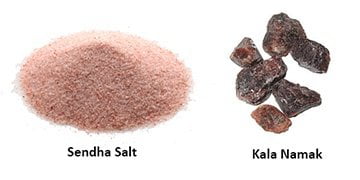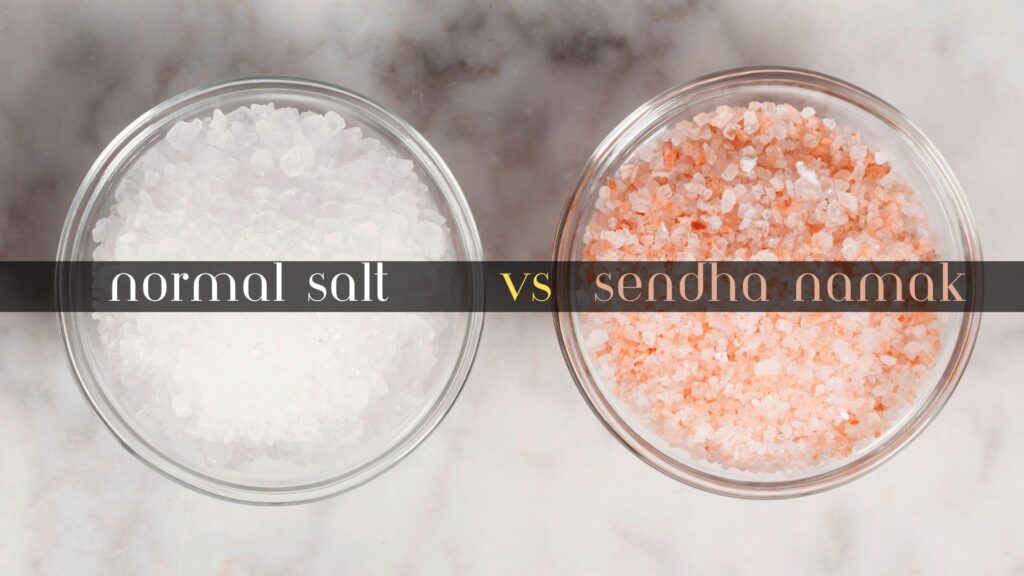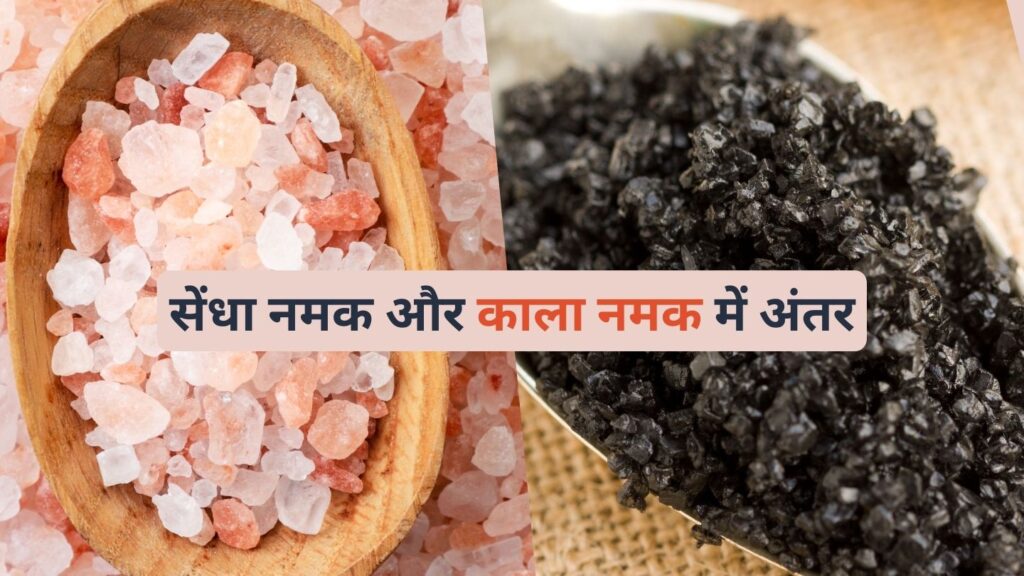Salt is a vital component of our diet, used for seasoning and enhancing the flavor of food and drinks. It is a crucial element in our kitchen, as it contains essential minerals such as sodium and iodine.
There are several varieties of salt available in the market, including common salt, Sendha Namak (rock salt), and Kala Namak (black salt).
However, with so many options, it can be challenging to determine which salt is most beneficial for our bodies. Therefore, it is essential to understand the differences between Kala Namak vs sendha namak to make an informed decision on which one to consume.
In this article, we will explore the various types of salt and their health benefits, helping you make an informed decision about which salt to include in your diet.
What is Sendha Namak (Pink Salt) –
Pink Salt, also known as Sendha Namak in Hindi, is believed to be the purest form of salt. It has a light pink color in its crystal form and appears white when powdered.
This type of salt is primarily found in Pakistan and is obtained from large mines in the Himalayas, which is why it is also referred to as Himalayan salt.
Pink Salt contains several elements like manganese, potassium, calcium, iron, zinc, and iodine, making it a beneficial option for consumption.
Additionally, it is commonly used in Ayurvedic and medicinal practices. Unlike sea salt, Sendha Namak (Pink Salt) does not contain any toxic elements, making it a healthier option. It has a cooling effect and is pure, making it a preferred choice during fasting, and is commonly used in cooking.
What is Kala Namak (Black Salt)-
Kala Namak (also known as black salt) is a type of salt that is similar to normal salt in terms of its taste but has a distinct color and smell. Its crystal form has a dark brown color, while in powder form, it appears dark pink.
The smell of Kala Namak is similar to that of a boiled egg. The presence of the sulfur element in Kala Namak is responsible for this smell.
Additionally, Kala Namak is abundant in iron, which gives it its characteristic black color. This type of salt is obtained from natural salt mines located in India, Nepal, Bangladesh, and Pakistan. It is also found in India’s Sambhar Lake.
Difference Between Sendha Namak and Kala Namak
| Sendha Namak | Kala Namak | |
|---|---|---|
| Naturalness | Completely natural | Not completely natural |
| Purity | Pure | Not pure |
| A preferred choice for fasting food | Yes | No |
| Crystal form (color) | Light pink | Dark brown |
| Powder form (color) | Pale pink or white | Dark pink |
| Found in | Punjab, Himalayas, and some dry lakes in Pakistan | India, Pakistan, Nepal, Bangladesh, and Sambhar Lake of Rajasthan |
| Ayurvedic use | To remove pitta dosha | To remove gas, constipation, and digestive problems |
| Health benefits | Good for the heart and can help prevent diabetes, maintain blood pressure, and keep blood vessels flexible | No special benefit can help reduce hair breakage, split ends, and cracked heels. Provides relief for foot sprains by soaking feet in warm water containing Kala Namak. |
- Kala Namak is not completely natural, while Sendha Namak is entirely natural.
- Sendha Namak is pure, whereas Kala Namak is not pure, making Sendha Namak the preferred choice for fasting food.
- Sendha Namak is light pink in crystal form, while Kala Namak is dark brown in crystal form.
- Sendha Namak is pale pink or white in powder form, while Kala Namak is dark pink in powder form.
- Sendha Namak (Pink Salt) is found in Punjab, the Himalayas, and some dry lakes in Pakistan, while Kala Namak (black salt) is located in India, Pakistan, Nepal, and Bangladesh. Kala Namak is also found in the Sambhar Lake of Rajasthan.
- In Ayurveda, Sendha Namak (Pink Salt) is used to remove pitta dosha, while Kala Namak (black salt) is used to remove gas, constipation, and digestive problems.
- Eating Sendha Namak (Pink Salt) is good for the heart and can help prevent diabetes, while Kala Namak (black salt) does not provide any special benefit.
- Consuming Sendha Namak can help maintain blood pressure and keep blood vessels flexible while consuming Kala Namak can help reduce hair breakage, split ends, and cracked heels. It can also relieve foot sprains by soaking feet in warm water containing Kala Namak.
kala Namak Vs Sendha Namak: Main Difference?

The main difference between Kala Namak (black salt) and Sendha Namak (pink salt) is that Sendha Namak is completely natural, while Kala Namak is not. Sendha Namak is pure and light pink, while Kala Namak is dark brown in crystal form and dark pink in powder form.
Sendha Namak is found in Punjab, the Himalayas, and some dry lakes in Pakistan, while Kala Namak is found in India, Pakistan, Nepal, and Bangladesh, as well as the Sambhar Lake of Rajasthan.
In Ayurveda, Sendha Namak is used to remove pitta dosha, while Kala Namak is used to remove gas, constipation, and digestive problems. Eating Sendha Namak is good for the heart and can help prevent diabetes while consuming Kala Namak does not provide any special benefit.
Read More: काला नमक, सेन्धा नमक और साधारण नमक में क्या अंतर है?
After exploring the different types of salt, it is evident that Sendha Namak is the most beneficial for our health compared to other types of salt. It protects against many diseases that can occur in our bodies.
In addition to being pure, Sendha Namak is rich in various essential minerals that our body requires. Therefore, it is highly recommended to use Sendha Namak in our daily diet to reap its numerous health benefits.
FAQs
Q1. What is the difference between Kala Namak and Sendha Namak?
Ans: Kala Namak (black salt) is not entirely natural and has a distinct smell and taste, while Sendha Namak (pink salt) is entirely natural and has a light pink color. Sendha Namak is also the preferred choice for fasting food.
Q. 2 is black salt and sendha namak same?
Ans: No, Black salt and Sendha Namka is not same. Black salt is a common ingredient in Indian cuisine. Due to sulfur compounds, it has a distinct sulfurous smell and taste. On the other hand, sendha namak is a type of salt that is used during Hindu fasting periods (such as Navratri and Shivratri).
The image is mentioned below for your reference:

Q3. Where is Sendha Namak found?
Ans: Sendha Namak is primarily found in Pakistan, in large mines in the Himalayas. It is also referred to as Himalayan salt.
Q. 4. Is Rock Salt and Sendha Namak Same?
Ans: Yes, rock salt and sendha namak are the same.



